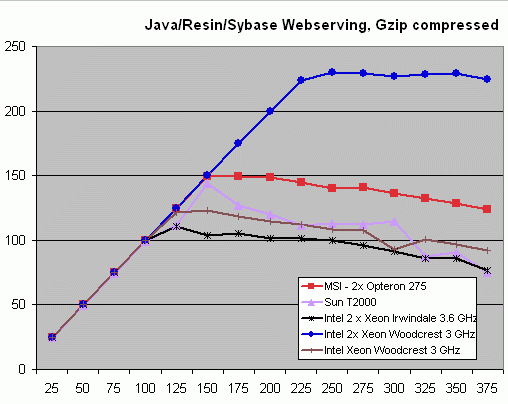Intel Woodcrest, AMD's Opteron and Sun's UltraSparc T1: Server CPU Shoot-out
by Johan De Gelas on June 7, 2006 12:00 PM EST- Posted in
- IT Computing
Java Webserving
As promised, we are also introducing a real world web server based on Java Server Pages (JSP). The next benchmark is based on the production Ace's Hardware message board, written by Brian Neal and Chris Rijk. This highly optimized jsp real world application uses a 2 GB object cache to minimize database access. As optimized as it may be, building up the message tree or index of the message boards and compressing it with gzip requires quite a bit of CPU power.
The benchmarked software includes:

Although this should be Sun's favored benchmark, the new Xeon Woodcrest is a real party pooper for Sun. A single 80 Watt Woodcrest 3 GHz delivers almost the performance of one T1 at 1 GHz. Luckily for Sun, it is only fair to compare the top model of Intel to Sun's own top model at 1.2 GHz, and Sun should still have a decent advantage when it comes to performance/Watt: the T1 1.2 GHz is about 20% faster than the fastest Woodcrest. However, the days where one 72 W T1 could outperform four Xeon cores while consuming about 4 times less power are over.
The new Xeon 5160, a.k.a. Woodcrest, is making it very hard for Sun to compete on price/performance: four Woodcrest cores are about twice as fast as the 8 core T1. It is interesting to note that the simple T1 core is almost doing as much work per cycle as the massive Opteron. It has twice as many cores, but they are running at half the clockspeed of the Opteron and offering - on average - only 13% lower performance. If we compare the fastest Opteron (2.6 GHz Dual core) with the fastest T1 (1.2 GHz), this proportion shouldn't change much. So a simple 1-way core with 4 threads can do as much work as pretty complex 3-way core with one thread. However, the Woodcrest CPU does not only perform better per clock, it also reaches a 3 GHz clock. Intel beats Sun here in their home territory.
AMD is also in quite a bit of trouble too. If we extrapolate our 2.4 and 2.2 GHz numbers, an Opteron at 3 GHz would still be about 25% slower than our Woodcrest at 3 GHz. Impressive!
As promised, we are also introducing a real world web server based on Java Server Pages (JSP). The next benchmark is based on the production Ace's Hardware message board, written by Brian Neal and Chris Rijk. This highly optimized jsp real world application uses a 2 GB object cache to minimize database access. As optimized as it may be, building up the message tree or index of the message boards and compressing it with gzip requires quite a bit of CPU power.
The benchmarked software includes:
- Caucho Technology's Resin 2.1.17
- Java Virtual Machine: Java HotSpot(TM) Server VM (build 1.5.0_04-b05)
- Sybase ASE 15.0 for Solaris / Linux

Although this should be Sun's favored benchmark, the new Xeon Woodcrest is a real party pooper for Sun. A single 80 Watt Woodcrest 3 GHz delivers almost the performance of one T1 at 1 GHz. Luckily for Sun, it is only fair to compare the top model of Intel to Sun's own top model at 1.2 GHz, and Sun should still have a decent advantage when it comes to performance/Watt: the T1 1.2 GHz is about 20% faster than the fastest Woodcrest. However, the days where one 72 W T1 could outperform four Xeon cores while consuming about 4 times less power are over.
The new Xeon 5160, a.k.a. Woodcrest, is making it very hard for Sun to compete on price/performance: four Woodcrest cores are about twice as fast as the 8 core T1. It is interesting to note that the simple T1 core is almost doing as much work per cycle as the massive Opteron. It has twice as many cores, but they are running at half the clockspeed of the Opteron and offering - on average - only 13% lower performance. If we compare the fastest Opteron (2.6 GHz Dual core) with the fastest T1 (1.2 GHz), this proportion shouldn't change much. So a simple 1-way core with 4 threads can do as much work as pretty complex 3-way core with one thread. However, the Woodcrest CPU does not only perform better per clock, it also reaches a 3 GHz clock. Intel beats Sun here in their home territory.
AMD is also in quite a bit of trouble too. If we extrapolate our 2.4 and 2.2 GHz numbers, an Opteron at 3 GHz would still be about 25% slower than our Woodcrest at 3 GHz. Impressive!










91 Comments
View All Comments
zsdersw - Wednesday, June 7, 2006 - link
Umm.. no. Woodcrests won't cost $1000. Xeons have always cost less than the EE chips.